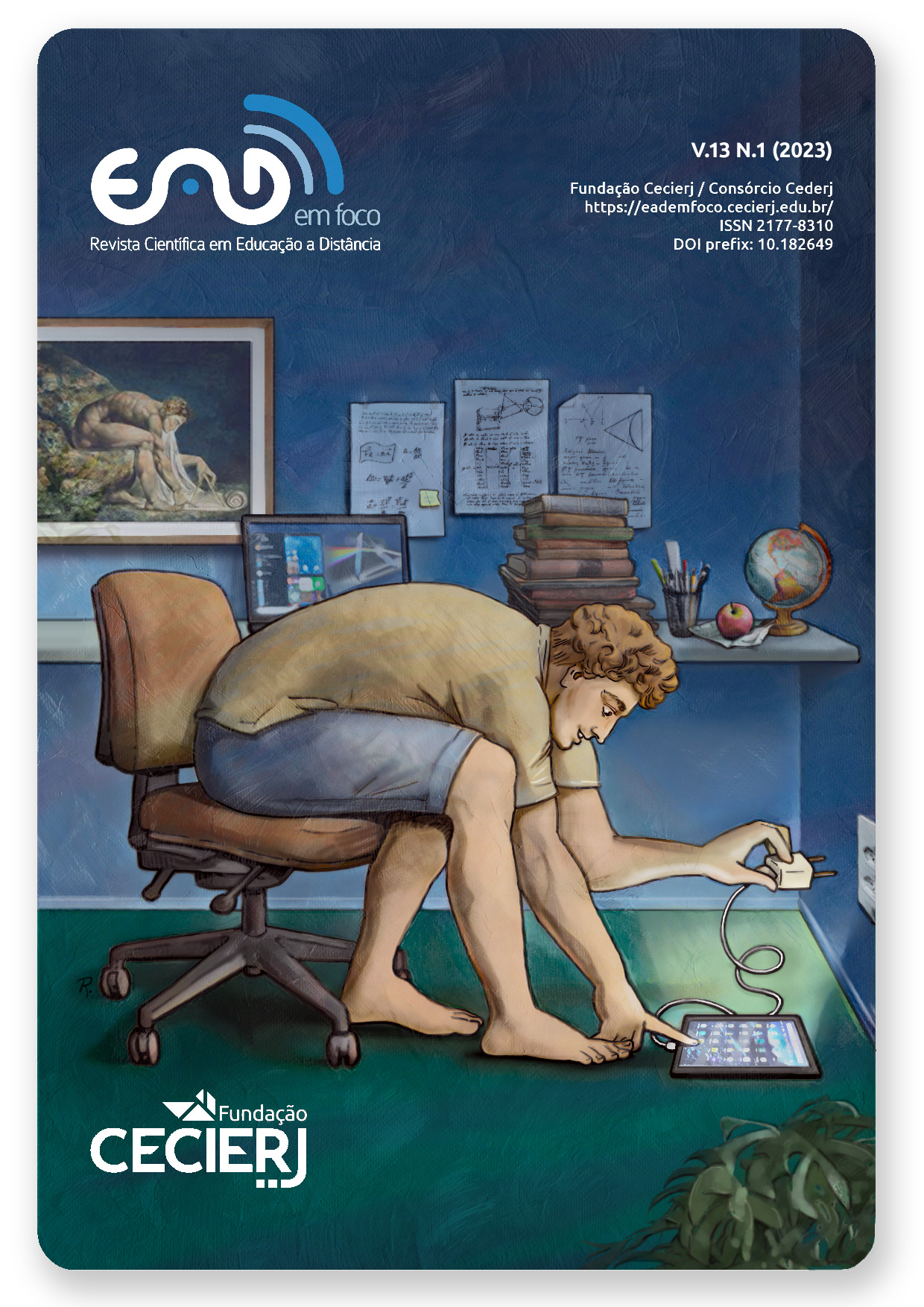Assessing Distance Learning: Quality, Satisfaction and Critical Success Factors as User Experience Factors
DOI:
https://doi.org/10.18264/eadf.v13i1.1954Keywords:
Distance learning , Service designAbstract
Evaluations of distance education can be approached through different prisms - including the User Experience (UX) with the service. However, it is necessary to understand how to carry out evaluations within this scope. The objective of this article is to analyze processes and dimensions used in the evaluation of distance education artifacts through the constructs of Quality, Satisfaction and Critical Success Factors, and whether such results can be related to the discipline of UX and its application in the evaluation of e-learning services. The study, exploratory, quantitative-qualitative and descriptive, begins with a Systematic Mapping of Literature, and after, the results are discussed in the light of User Experience (UX). As a result, the literature on the subject is the most used source to define the dimensions of evaluation, however most studies aim to confirm whether the dimensions are adequate to empirical contexts of analysis, with e-learning geared towards higher education - the most studied object. Two major dimensions were categorized: Service (with 9 sub-dimensions) and User (with 3 sub-dimensions). It is considered that the dimensions can be related to the UX approach, being used as a starting point to structure studies aimed at the evaluation of e-learning, especially higher education. The results can collaborate for the construction of methods and tools based on UX, and that evaluate services in such context.
Keywords: Distance learning. Service design. User experience.
Downloads
References
ABNT. Associação Brasileira de Normas Técnicas. NBR ISO 9001:2015. Sistemas de gestão da qualidade: Requisitos. 2015.
APARICIO, M.; BACAO, F.; OLIVEIRA, T. Cultural impacts on e-learning systems’ success Internet High. Education, n.31, p.58–70, 2016.
BRADFORD, G. R. A relationship study of student satisfaction with learning online and cognitive load: Initial results. The Internet and Higher Education, vol. 14, n.4, p.217–226, 2011.
BRASIL. Ministério da Educação. O que é educação a distância? 2016. Disponível em: http://portal.mec.gov.br/escola-de-gestores-da-educacao-basica/355-perguntas-frequentes-911936531/educacao-a-distancia-1651636927/12823-o-que-e-educacao-a-distancia - Acesso em: 8 de Set. de 2022.
CHEAWJINDAKARN, B.; SUWANNATTHACHOTE, P.; THEERAROUNGCHAISRI, A. Critical success factors for online distance learning in higher education: a review of the literature. Creative Education, Vol. 3, n.8, p.61-66, 2012.
EHLERS, U. Quality in e-Learning from a Learner’s Perspective. European Journal of Open, Distance and E-Learning, n.23, outubro 2018. Oldenburg, Germany. 2018.
GOODMAN, E.; KUNIAVSKY, M.; MOED, A. Observing the user experience: a practitioner's guide to user research. 2nd ed. Amsterdam: Elsevier, Morgan Kaufmann, 2012.
GOKCE, S. Um guia para o feedback dos usuários: como coletar e usar. 2022. Disponível em: https://userguiding.com/pt-br/blog/feedback-dos-usuarios - Acesso em: 16 de Out. de 2022.
HASSENZAHL M. et al. Experience-oriented and product-oriented evaluation: psychological need fulfillment, positive affect, and product perception. International Journal of Human Computer Interaction. 2015, v.31, n.8, p. 530–544. 2015.
HASSENZAHL, M. User Experience (UX): Towards an experiential perspective on product quality. 2008. Não paginado. Disponível em: http://www.marc-hassenzahl.de/pdfs/hassenzahl-ihm08.pdf - Acesso em: 10 abr 2021.
INEP. Instituto Nacional de Estudos e Pesquisas Anísio Teixeira. Censo da Educação Superior 2019. Disponível em: https://www.gov.br/inep/pt-br/areas-de-atuacao/pesquisas-estatisticas-e-indicadores/censo-da-educacao-superior/resultados - Acesso em: 22 fevereiro de 2021.
ISONORM. International Organization for Standardization. Ergonomics of human-system interaction. Part 11: Usability: Definitions and concepts. 2018. Disponível em: https://www.iso.org/obp/ui/#iso:std:iso:9241:-11:ed-2:v1:en - Acesso em: 15 julho 2021.
KITCHENHAM, B.; CHARTERS, S. Guidelines for performing systematic literature reviews in software engineering. Technical Report EBSE 2007-001, Keele University and Durham University Joint Report, 2007.
KRIPPENDORFF, K. The semantic turn: a new foundation for design. Boca Raton: Taylor&Francis, 2006.
NAVIMIPOUR, N. J.; ZAREIE, B. A model for assessing the impact of e-learning systems on employees’ satisfaction. Computer Human Behavior, n.53, p. 475-485, 2015.
NIELSEN, J.; NORMAN, D. The Definition of User Experience. In: Nielsen Norman Group. Evidence-Based User Experience Research, Training, and Consulting. [site]. Fremont, CA, 2014. Disponível em: https://www.nngroup.com/articles/definition-user-experience - Acesso em: 20 jan. de 2021.
PARASURAMAN, A. et al. A Conceptual Model of Service Quality and Its Implications for Future Research. Journal of Marketing, n.49, p. 41-50. 1985.
PRESS, M.; COOPER, R. El diseño como experiência: el papel del diseño y los diseñadores en el siglo XXI. Barcelona: Gustavo Gili, 2009.
RABIN, E.; KALMAN, Y.; KALZ, M. An empirical investigation of the antecedents of learner-centered outcome measures in MOOCs. International Journal of Educational Technology in Higher Education. 2019.
REMATAL, D. R. C.; BEHAR, P. A.; MAÇADA, A. C. G. Elementos de gestão para educação a distância: um estudo a partir dos fatores críticos de sucesso e da visão baseada em recursos. Revista Renote - Novas tecnologias na educação. Rio Grande do Sul, v. 7, n. 1, julho, 2009. Disponível em: http://seer.ufrgs.br/renote/article/view/13974 - Acesso em: 12 jul. 2021.
RIVERO, L.; CONTE, T. A systematic mapping study on research contributions on UX evaluation technologies. In.: Proceedings of the 16th Brazilian Symposium on Human Factors in Computing Systems (IHC 2017), Joinville, Brazil. 2017.
SAFFER, D. Designing for interaction: creating smart application and clever devices. Berkeley: New Riders, 2007.
SCHIFFERSTEIN, H.; HEKKERT, P. Product Experience. London: Elsevier, 2008.
SHRAIM, K. Y. Quality Standards in Online Education: The ISO/IEC 40180 Framework. iJET, vol. 15, n.19, 2020.
SWART, W.; WENGROWICZ, N.; WUENSCH, K. Using transactional distances to explore student satisfaction with group collaboration in the flipped classroom. International Journal of Information and Operations Management Education, vol.6, n.1, p. 24-48, 2015.
TULLIS T.; ALBERT B. Measuring the User Experience. Amsterdam: Morgan Kauffman, 2013.
VÄÄNÄNEN-VAINIO-MATTILA, K.; SEGERSTÅHL, K. A Tool for Evaluating Service User eXperience (ServUX): Development of a Modular Questionnaire. In.: Interact 2009 conference, User Experience Evaluation Methods in Product Development (UXEM'09), 2009. Proceedings. Workshop in Interact'09 conference, Uppsala, Sweden, 2009.
WENGROWICZ, N. et al. Students’ Collaborative Learning Attitudes and Their Satisfaction with Online Collaborative Case-Based Courses. American Journal of Distance Education, p. 283-300. 2018.
WOOD, D. J. et al. Stakeholder Identification and Salience After 20 Years: Progress, Problems, and Prospects. Business & Society, 60(1), 196–245. 2021.
Published
How to Cite
Issue
Section
License
Copyright (c) 2023 EaD em Foco

This work is licensed under a Creative Commons Attribution 4.0 International License.
All articles published in Revista EaD em Foco receive the license
Creative Commons - Atribuição 4.0 Internacional (CC BY 4.0).
All subsequent publications, complete or partial, must be made with the acknowledgment, in citations, of the Revista EaD em Foco as the original editor of the article.













